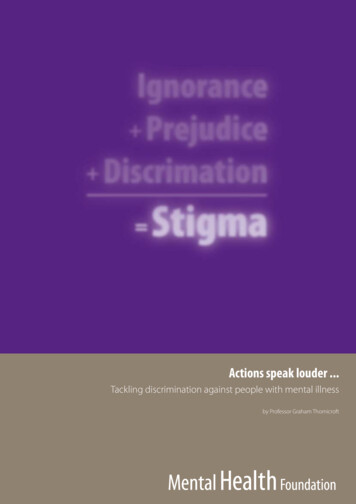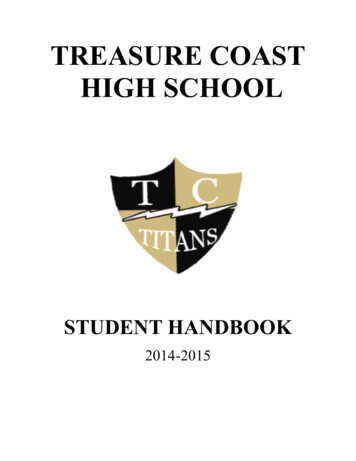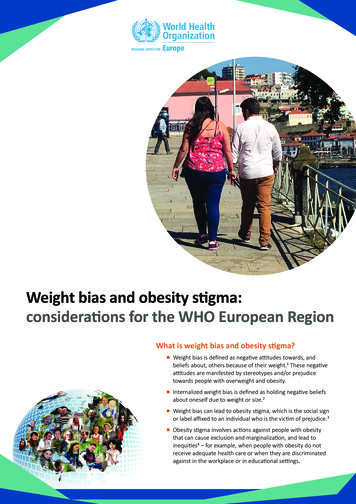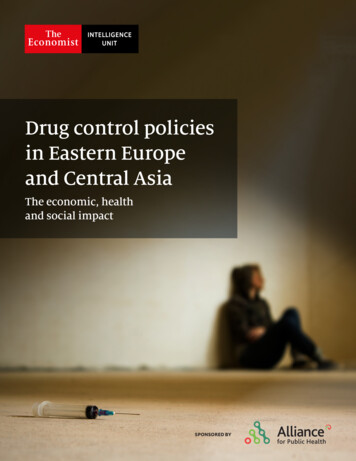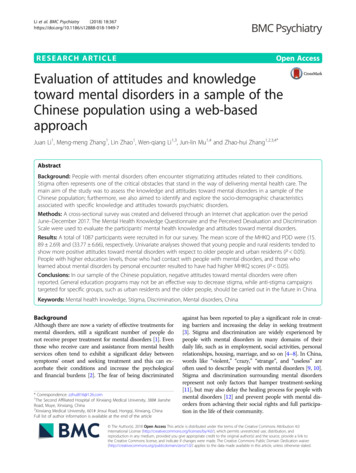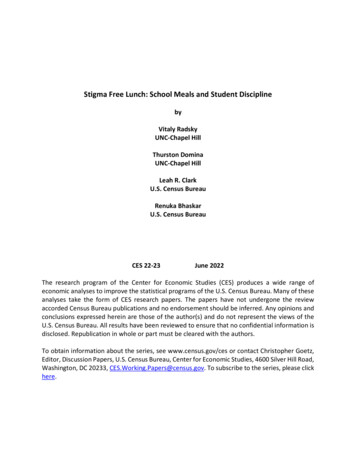
Transcription
Stigma Free Lunch: School Meals and Student DisciplinebyVitaly RadskyUNC-Chapel HillThurston DominaUNC-Chapel HillLeah R. ClarkU.S. Census BureauRenuka BhaskarU.S. Census BureauCES 22-23June 2022The research program of the Center for Economic Studies (CES) produces a wide range ofeconomic analyses to improve the statistical programs of the U.S. Census Bureau. Many of theseanalyses take the form of CES research papers. The papers have not undergone the reviewaccorded Census Bureau publications and no endorsement should be inferred. Any opinions andconclusions expressed herein are those of the author(s) and do not represent the views of theU.S. Census Bureau. All results have been reviewed to ensure that no confidential information isdisclosed. Republication in whole or part must be cleared with the authors.To obtain information about the series, see www.census.gov/ces or contact Christopher Goetz,Editor, Discussion Papers, U.S. Census Bureau, Center for Economic Studies, 4600 Silver Hill Road,Washington, DC 20233, CES.Working.Papers@census.gov. To subscribe to the series, please clickhere.
AbstractWe investigate the effect of the Community Eligibility Provision (CEP) of the National SchoolLunch Program on student suspension rates. CEP allows high-poverty schools to offer free mealsto all students regardless of their family’s household income. We conceptualize CEP as a strategyto alleviate well-documented stigma associated with school meals. As such, we hypothesize thatCEP implementation will reduce the incidence of suspensions, particularly for students from lowincome backgrounds and minoritized racial and ethnic groups. We construct a unique paneldataset that links educational records for K-12 students enrolled in Oregon public schoolsbetween 2010 and 2017 with rich administrative data records describing their families’household income and social safety net program participation. Difference-in-difference analysesindicate that CEP implementation has a measurable protective effect on suspension rates inparticipating schools. These effects are pronounced for students from low-income families andHispanic students.Keyword: Community Eligibility Program; School Discipline; School Lunch.JEL Classification: I21, I24, I28, I32*Any opinions and conclusions expressed herein are those of the authors and do not represent the views of theU.S. Census Bureau. The Census Bureau has reviewed this data product for unauthorized disclosure of confidentialinformation and has approved the disclosure avoidance practices applied to this release. DRB Approval Number:CBDRB-FY22-CES014-012.*
“I learned I was poor on the new lunch lady’s first day at work.”-Psychologist Kenneth Payne, The Broken Ladder: How Inequality Affects the Way WeThink, Live, and Die (2017, p. 11)Elementary and secondary schools distribute free or subsidized meals to some 30 millionstudents across the United States on the average school day via the National School LunchProgram (NSLP), at a cost of approximately 14 billion annually (USDA 2022). These mealsrepresent one of the largest child nutrition and development programs in the contemporary U.S.and provide a crucial nutritional supplement to young people across the country who are at riskof food insecurity (Gordon et al. 2007).Schools collect data on students’ family income and use these data to determine whichstudents are eligible to receive free or subsidized meals. In doing so, schools enact social categoriesthat are closely linked to student socioeconomic background. Schools reinforce these incomebased categories via daily rituals that demarcate poor and non-poor students. For example, schoolsmay ask students from relatively low-income backgrounds to line up for school meals and producea lunch ticket to pay for their meals while more affluent students sit to eat their bagged lunches(Best 2017; Poppendieck 2011).In this paper, we investigate the consequences of these income-based school lunchcategories by estimating the effects of a policy that eliminates them: The Community EligibilityProvision (CEP) of NSLP. When schools implement CEP, they offer free meals to all studentsregardless of their family’s household income, suspending processes that distinguish betweenstudents who receive free or subsidized meals and those who must pay full price. Eligibleschools and school districts across the United States have implemented CEP in a staggeredfashion since the program’s launch in the 2014-15 school year, with a smaller number of statesstarting earlier under the pilot program. At the start of the 2019-20 school year, nearly 70 percent3
of eligible schools –approximately 1 in 3 public K-12 schools – participated in CEP (FRAC2020).Our work, which developed in the context of a broader project assessing the use of freeand reduced-price lunch data as a proxy for student economic disadvantage (Domina et al. 2018)and responds to calls for increased attention to the foundational role that school meals play in thesocial organization of the school and the development of youth identities (Best 2017, WeaverHightower 2011), conceptualizes CEP as an intervention that alleviates a source ofsocioeconomic stigma in participating schools. Alleviating the stigma associated with free andreduced-price lunch likely has diverse consequences in the social order of the school, includingencouraging more students to participate in school meals and reducing the salience of social classin teacher expectations and peer dynamics. Drawing upon prior scholarship that positions stigmaat the heart of a vicious cycle that drives exclusionary discipline (Okonofua et al. 2016) – wefocus attention on the effects of CEP on student suspensions. Prior research suggests that theimplementation of CEP and other universal school meal programs boost student achievement(Gordanier et al. 2020, Kitchen et al. 2013; Ruffini 2021, Schwartz & Rothbart 2020) andattendance (Bartfield, Berger, & Men 2020). While limited evidence regarding the program’seffect on suspensions is currently available (Gordon & Ruffini 2020; Kho 2018), we hypothesizethat CEP reduces the incidence of suspensions in treated schools and that this negative effectincreases over time as the stigma associated with free lunch fades and schools implement newuniversal free lunch routines. We further hypothesize that the program’s benefits will beparticularly pronounced for students from groups that are most at risk of group-based stigma inschool, including students from socioeconomically disadvantaged families, and students fromminoritized racial and ethnic groups.4
Our analyses take advantage of a unique dataset consisting of administrative datadescribing all students enrolled in Oregon public schools between 2010 and 2017 merged withhousehold-level data from the U.S. Census Bureau describing Internal Revenue Service (IRS)reported earnings and Supplemental Nutrition Assistance Program (SNAP) participation.Focusing analyses on 567,000 elementary, middle, and high school students enrolled in schoolsthat were eligible to participate in CEP, we execute a difference-in-differences study design,comparing changes in suspension rates for students enrolled in schools that implement CEP withcontemporaneous suspension rate changes for students in schools that do not implement CEP.Our design, which takes advantage of CEP’s staggered implementation across eligible schools,generates plausibly causal estimates of program treatment by assuming suspension trends forschools that implement CEP would move in parallel to trends for schools that do not, if not forthe implementation of CEP. Although CEP rolled out in a period of rapid decline in the use ofsuspensions in Oregon schools, our analyses indicate that this identifying assumption holds.We find that CEP implementation led to a further decline in suspensions for students intreated schools, with statistically significant effect size estimates equivalent to an approximately15 percent decline in suspension rates in the third year of CEP implementation. Our uniquestudent-level data linkages – and, in particular, IRS and SNAP data that characterize familyeconomic resources – allow us to investigate the distinctive effects of CEP implementation onstudents from low-income families, during a period where the NSLP indicator becomesunreliable as a proxy for family income. We find that CEP has a particularly pronouncedprotective effect for low-income students, as well as Hispanic students (the state’s largestminoritized student group). These subgroup findings, in particular, represent a new contributionto our understanding of which students are most affected by school lunch stigma and its removal5
via CEP. They also highlight the critical importance of reliable measures of family economiccircumstances in education research.Community Eligibility Provision and universal school lunchMeal programs in U.S. schoolsFounded in 1946 and expanded considerably in the late 1960s and early 1970s, theNational School Lunch Program has often been primarily conceptualized as an anti-povertyprogram that targets free and low-price meals to students at risk of food insecurity (Levine2008). USDA operates NSLP, and its regulations require schools to provide free or reduced-pricelunch application to all students at the beginning of the school year and make applicationsavailable upon request at any time. These applications ask students to demonstrate theireligibility for free or reduced-price lunch by reporting their household’s total income from allsources in the prior month. Under the policy, students who demonstrate income-eligibilityremain enrolled for the entirety of a school year. Students qualify for free lunches if theirfamilies report household incomes less than 130 percent of poverty and reduced-price lunches ifthey report income between 130 and 185 percent of poverty. Students who do not apply for theprogram or whose families report income greater than 185 percent of poverty must pay forschool lunches.Several policy initiatives implemented since the 1980s have attempted to streamline theprocess of enrolling in free or reduced-price lunch, allowing students whose families participatein SNAP, Temporary Assistance for Needy Families (TANF), and other means-tested federalprograms as well as homeless, migrant, and foster children to enroll without submitting anapplication via a procedure known as “direct certification.” Other relatively recent policy6
initiatives allow participating schools to automatically re-enroll students who had previouslydemonstrated income eligibility without completing an annual application.Authorized as part of the 2010 Healthy, Hunger-free Kids Act of 2010, CEP dramaticallyexpanded and accelerated the policy movement to streamline and expand access to free schoolmeals. Schools, groups of schools, or districts in which in which 40 percent or more of studentsdirectly certify for free lunch by participating in SNAP or other means-tested federal programscan opt into CEP. Once they do so, participating schools offer free lunch and breakfast to allstudents, regardless of their demonstrated need, receiving funding under a National SchoolLunch Program reimbursement formula. The formula, however, makes the program lessappealing for schools and districts that are just barely eligible – these schools run the risk of notcovering their meal expenses through NSLP reimbursement alone, and may have to dip intoother revenue sources to cover universal breakfast and lunch expenses. These incentives leaveplenty of room for eligible schools to opt in or out based on the financial and political support forthe program locally.Existing evidence on the effects of universal school mealsRecent evaluations of CEP implementation in U.S. schools as well as studies of universalmeal provision in other policy contexts indicate that universal meal provision boosts studentparticipation in school meals (Schwartz & Rothbart 2019; Ruffini 2021; Turner, Guthrie &Ralston 2019; Pokorney, Chandran & Long 2019; Rothbart, Schwartz, & Gutierrez 2020;Gordanier et al. 2020; Kitchen et al. 2013). While it is difficult to directly compare themagnitude of changes in meal participation across settings, the results typically suggest thatstudents in schools with universal lunch provision are 5-10 percentage points more likely toparticipate in school lunch than they were in means-tested lunch provision. This literature7
provides some evidence to suggest that increases in meal participation are particularlypronounced for the relatively economically advantaged students who would have previously hadto pay for meals. However, these studies find positive effects in meal receipt for lower-incomefree or reduced-price eligible students as well.This growing research literature further indicates that universal meal provision positivelyaffects students’ academic and behavioral outcomes. Several studies indicate that universal mealprovision modestly but significantly boosts student math achievement, with average effect sizeestimates ranging from 0.04 to 0.06 standard deviations (Bartfield, Berger, & Men 2020;Gordanier et al. 2020; Kitchen et al 2013; Ruffini 2021). While there is some evidence to suggestthat universal meals have similar positive effects on reading achievement (Schwartz & Rothbart2019), other studies show no effects on this achievement outcome (Gordanier et al. 2020, Ruffini2021). Further, the existing literature indicates that universal meal provision improveselementary school student attendance (Gordanier et al. 2020; Barfield, Berger & Mann 2020),though it is unclear whether these positive effects generalize to secondary school settings.Relatively little evidence is currently available regarding the effects of universal meals onstudent disciplinary outcomes. Using data from New York City, Gutierrez (2020) demonstratesthat school-level universal free meals program adoption drives notable improvements in studentperceptions of school climate, including reported declines in bullying and fighting in schools.Gordon & Ruffini (2020) take advantage of the fact that eight states participated in a CEP pilotprogram starting in 2012 (before the program extended nationwide in 2015) to estimate theeffects of attending a CEP-eligible school on suspension rates and other disciplinary outcomes.Gordon & Ruffini’s analyses use data from four waves of the Department of Education’s CivilRights Data collection, which reports the number of students suspended from more than 908
percent of U.S. public schools biennially since 2010. These analyses suggest that suspensionrates for elementary and middle school students in CEP-eligible schools fall modestly when CEPbecomes available to schools in their states. While informative, these estimates likely understatethe effect of school-level CEP participation, since only half of eligible schools had opted into theprogram by 2017. More directly relevant are findings from Kho’s (2018) unpublisheddissertation using data from Tennessee. Using a difference-in-differences approach, Kho findsthat student suspension rates remain unchanged during a school’s first year of CEP participationbut decline by 1.5 percentage points in their school’s 2nd year in the program and 2.3 percentagepoints in their school’s 3rd year in the program.A sociological account of the effects of universalizing school mealsMany existing evaluations of CEP and other universal meal programs invoke the conceptof stigma to explain the program’s effects. Goffman (1963, p. 3) describes stigma as an “attributethat makes [its holder] different from others in the category of persons available for him to be,and of a less desirable kind – in the extreme, a person who is quite thoroughly bad, or dangerous,or weak. He is thus reduced in our minds from a whole and usual person to a tainted, discountedone.” Link & Phelan (2001, p, 367) elaborate, writing that “we apply the term stigma whenelements of labeling, stereotyping, separation, status loss, and discrimination co-occur in a powersituation that allows the components of stigma to unfold.” We argue that means-testing activatesstigma by associating school meals with poverty.Students who come of age in schools that provide free or reduced-price meals to incomeeligible students often use terms such as “disgusting” and “welfare food” to describe schoolmeals (Poppendieck 2010). Participation in means-tested free- or reduced-price school lunchprograms marks students as disadvantaged in the eyes of their teachers and peers, who consider9
packed lunches from home as a mark of status and affluence (Weaver-Hightower 2011; Best2017). The processes through which schools distribute means-tested meals may contribute toschool meal stigma, by shaping teachers’ impressions of students who eat school meals andcreating both physical and social distance between meal recipients and their school peers. Thisstigma may lead many students – including the income-eligible and their relatively affluent peers– to opt out of school-provided meals (Mirtcheva & Powell 2009). Further, it likely raises thesalience of student social class and other ascriptive student characteristics associated with socialclass in school status hierarchies.School meals and teacher perceptionsOne way the means-tested allocation of school meals create stigma is by shapingteachers’ expectations for student behavior and educational achievement. Generations ofscholarship in the sociology of education draws attention to the ways student social classstructures the relationship between teachers and administrators, who typically hail from middleclass backgrounds, and their socioeconomically diverse students. Rist’s (1970) documents howinformation that teachers gather from social workers, fellow teachers, and interactions withparents about their students’ family backgrounds shapes teacher expectations of student behaviorand ability even before teachers begin to interact substantially with students. In schools in whichschool meal distribution is means-tested, teachers distribute applications for free- or reducedprice lunch applications to students and their families, encouraging families to apply, andcollecting and submitting applications once they have been completed, and then organizingstudents into lines at meal time. As such, the means-tested allocation of school lunches likelyprovides teachers with information to infer students’ socioeconomic status. These inferences canhave long-lasting consequences: A rich body of sociological research demonstrates that can help10
to explain why teachers underestimate poor students’ academic ability (Ready & Wright 2011),motivation (Auwarter & Aruguete 2008; Jussim et al. 1987), and behavior (Dunkake &Schuchart 2015, Calarco 2018).School meals and student social dynamicsFurthermore, since school meals represent one of the few periods in the school days inwhich young people have relative autonomy, students’ lunchtime socializing often defines theirsocial experiences in the school, shaping both the way students see themselves and the way theyare seen by others in the school environment (Milner 2013, Best 2017; Calarco 2018). Asstudents sort into school lunch groupings, they often develop peer subcultures, distinguished bydistinct norms of dress and self-presentation, behavior, and status ranking in the school’s socialhierarchy. Reflecting on the school lunchroom’s role in his high school’s social life, one studentrecounts: “[There was] a great deal of concern as to what the lunch arrangements would be. Asfreshmen, people scurried around the lunch room, searching desperately for friends to sit with, sothat they would not have to suffer the ultimate embarrassment of eating alone or sitting at anuncool table.” Another adds: “I always felt that my level of coolness was being judged by therespective status of each individual I was with.” (Milner 2013, p. 61).The mechanisms of means-tested lunch distribution may increase the salience of socialclass at mealtime and throughout the school day. To receive school meals, students must line upand collect their food on a distinctive school meal tray before they sit and eat. In many schoolsthey must further disclose their meal status at the point of payment. Students who opt out ofschool meal programs, meanwhile, can often proceed straight to their meals. Furthermore, as agrowing number of schools begin to offer unsubsidized a la carte meal options, students who canafford to do so may skip the school meal line and pay by cash for more desirable snack foods11
(Best 2017; Poppendieck 2011). In each of these cases, the processes of means-tested schoolmeal distribution sort and spatially segregate students, influencing how students socialize in thelunchroom and contributes to the association between social class and student social networksand identities (Best 2017).Meal stigma and school disciplineMeal stigma likely has a wide range of negative consequences. In some cases, stigmamay lead students to skip school meals, going hungry rather than risking the stigma associatedwith poverty. In other cases, free meal participation may mark students (in their own eyes, in theeyes of their peers, and in their teacher’s eyes) as poor. By allowing participating schools to offerfree meals to all students, the CEP renders the means-tested meal distribution mechanismsunnecessary, arguably mitigating meal stigma and its consequences for students.Doing so, we hypothesize, has downstream consequences for the disciplinary climate inparticipating schools. We imagine two mechanisms through which these consequences mightemerge:First, universal meal provision may improve student behavior by improving studentnutrition. Prior research clearly demonstrates that CEP and other universal meal provisionprograms boost student participation in school meal programs (Schwartz & Rothbart 2019;Ruffini 2021; Turner, Guthrie & Ralston 2019; Pokorney, Chandran & Long 2019; Rothbart,Schwartz, & Gutierrez 2020; Gutierrez 2021; Gordanier et al. 2020; Kitchen et al. 2013). Aseparate literature indicates that youth hunger and malnutrition are associated with externalizingbehaviors (Howard 2011; Kimbro & Denney 2015) and nutritional supports protect at-risk youthfrom suspensions and other forms of school discipline (Gennetian et al. 2016).12
Second, if universal meal provision reduces stigma and stereotyping associated withpoverty in schools, the CEP may interrupt vicious cycles that contribute to high rates ofexclusionary discipline, particularly among students who participate in free and reduced-pricelunch. Existing scholarship on disciplinary disparities focuses extensive attention on pronouncedand persistent racial disparities in exposure to school discipline (Anderson & Ritter 2017;Barrett, McEachin, Mills & Valant 2021; Gregory, Skiba, & Noguera 2010; Lindsay & Hart2017; Owens & McLanahan 2020; Freidus 2020). This research literature focuses on botheducator biases and student disengagement. Teachers, primed by racist stereotypes, subject Blackand Hispanic students to sharp behavioral scrutiny at school and issue disproportionatelydraconian punishments for even minor infractions (Gilliam et al. 2016; Okonofua & Eberhardt2015). In response, students of color come to believe that school is not for them and may behaveaccordingly (Borman et al 2021; Goyer et al. 2019; Kupchik, 2010). Although disciplinarydisparities based on social class and school meal participation are less well-studied than racialdisparities, students who are enrolled in school free or reduced-price lunch program aresuspended from school at nearly twice the rate of their more affluent peers (Anderson & Ritter2017, Barrett et al. 2019, Owens & McLanahan 2019). Traditional means-tested school mealprograms may contribute to these disparities by marking meal participants as poor, subjectinglunch recipients to particular scrutiny as they activate teachers’ and peers’ broader class-basedbiases, potentially on top of, or in exacerbation of, race-based biases.The nutrition and stigma mechanisms are entwined, because stigma is what preventssome eligible students from eating free lunch. The fact that universal free meal provision boostsuptake among previously ineligible students as well as low-income students suggests that the13
association of low socioeconomic status and free lunch fades alongside its nutritional reach. Wetherefore hypothesize that:1. CEP reduces the incidence of suspensions in treated schools.2. The effect of CEP on suspensions increases over time as schools implement new universalfree lunch routines and the stigma associated with free lunch fades.3. CEP has a particularly pronounced protective effect on suspensions for low-income students.4. CEP has a pronounced protective effect on suspensions for Hispanic students, the largestminoritized racial/ethnic group among Oregon public school students.DataTo test these hypotheses, we link student-level educational administrative data from theOregon Department of Education (ODE) with confidential microdata stored at the CensusBureau including SNAP records from the state of Oregon and income tax records from the IRS.The ODE data provide annual records on all students enrolled in Oregon public K-12 schoolsbetween 2009-10 and 2016-17. Students appear in SNAP when they are listed as members ofhouseholds in SNAP records; they appear in IRS records when they are claimed as dependentson IRS tax returns.Merging across these data sources is possible using Census’s Protected IdentificationKeys (PIKs), which are assigned to the three administrative data sources using the PersonIdentification Validation System. 2 As noted in Table 1, 96 percent of K-12 students in the ODEThis is a probabilistic matching approaching conducted by the Census Bureau that leverages personally identifiableinformation in the raw administrative data to assign an anonymous unique identifier known as a PIK. After theassignment of PIKs, personally identifiable information is removed to protect confidentiality and these anonymizedfiles can be accessed by approved researchers. For more information on the Person Identification Validation System,see Wagner and Layne (2014).214
data are assigned PIKs in this process. We exclude students without PIKs from our analysessince we need to be able to link students to the other data sources.Appendix A provides details on the variables we construct using the linked data. Onevariable of particular importance is the low income indicator, which leverages both SNAP andIRS data to identify students who likely live in households with income below 1.85 times thefederal poverty line. In addition to restricting our sample to students who have PIKs, we furtherrequire a non-missing value of the low income variable, since this variable is central to ourheterogeneity analyses. As shown in table 1, 6% of Oregon students do not have a low incomevalue, either because they do not have a PIK or because they do not appear on an IRS Form 1040record within the three years prior to the reference year and they do not receive SNAP at anypoint during the reference year. Our investigation of students missing the low income flag didnot support the assumption that all of these students are low income, thus, in dropping them, weproceed with the implicit assumption that they are missing at random. After restricting based onthe availability of PIK and income information, the data is reduced to 4.2 million student-yearobservations.To create our analytic sample, we additionally exclude students enrolled in schools thatare not eligible to participate in CEP, as well as a small number of students enrolled in extremelysmall schools (schools with fewer than 20 students), specialty schools managed directly by theirdistrict or the Oregon Department of Education, and schools that either opened or closed at anypoint during the study period. Schools are eligible for CEP if 40 percent or more of enrolledstudents directly certified for free school meals. Data on this measure, which the USDA refers toas the Identified Student Percentage (ISP), are available for Oregon between 2014-15 and 201617 from the Food Research and Action Center (FRAC) and the Center on Budget and Policy15
Priorities. However, since these data may be incomplete, we additionally use data on schoolSNAP rates, because SNAP participation is the main characteristic used to calculate ISP. Schoolsare marked as eligible for CEP if SNAP percentages are greater than 40 percent in the priorschool year, since the prior year’s rate determines current-year CEP eligibility. Finally, becausedistricts can group schools into CEP-eligible clusters based on the group ISP rate, we markedeligible all schools in districts where the entire district has a SNAP percentage of at least 40percent. This includes schools that may not be individually eligible for CEP, but are eligible aspart of a full district. These sample restrictions exclude roughly one-half of the full data, for ananalytic sample of 567,000 students and 2,104,000 student-year observations.Table 1 highlights the ways that students in CEP eligible schools differ from the averageOregon student. Since CEP is only available to schools and districts in which 40 percent or moreof students directly certify for free lunch by enrolling in SNAP or other means-tested socialservice programs, our analytic sample includes a higher proportion of low-income students,English language learners, and Hispanic students than the state overall. The analytic sample alsohas somewhat higher average suspension rates. Elementary schools are disproportionately likelyto be eligible for CEP and, accordingly, CEP schools have lower enrollment than the stateaverage. More notably, CEP-eligible schools are more likely to be enrolled in Provision 2, a CEPpredecessor that also provided free lunch to all student
- Psychologist Kenneth Payne, The Broken Ladder: How Inequality Affects the Way We Think, Live, and Die (2017, p. . to our understanding of which students are most affected by school lunch stigma and its removal . students in schools with universal lunch provision are 5-10 percentage points more likely to participate in school lunch than .

